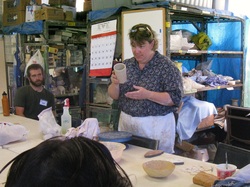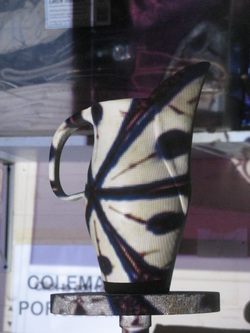Here's the general formula for black and brown stoneware:
Fire clays 30%
Ball clays 20%
Red clays 25% (if the red clay goes down, the feldspar can go up)
Feldspars 10%
Sands or grogs 15%
Silica can be added to adjust glaze fit (reduce crazing) and glass can be added to lower water absorption. Different proportions of iron and manganese are also added. The black color of Black Mountain, for instance, is largely due to added manganese dioxide.
If you're wondering, the proprietary information that Steve couldn't share included both precise proportions that go into any particular clay, and the exact types of clays, feldspars, sands, etc, that are used. Black Mountain, Jamaica, and Dark Brown are all different in composition, but the differences are minor.
On the wheel, I've found that Black Mountain, Jamaica, and Dark Brown are very similar in their throwing characteristics. I love working with all three because they're smooth and relatively plastic. Aardvark also offers a version of Black Mountain for handbuilders that has more "tooth."
When I first started working with Black Mountain, I had quite a bit of trouble with my bowls cracking, especially at the rim. That's because I dried the bowls too quickly and made the rims too thin. I knew that my pots were going to shrink as they lost water. They would shrink as they became greenware, shrink some more as they became bisque ware, and shrink even more as they became finished ware in the glaze kiln. Total shrinkage could vary from 10 to 15% depending on the clay, but it took me awhile to figure out how the loss of physical and chemical water might put stress on the structure of my pots, especially if water was moving out of the clay unevenly. I figured that the only wrong way to dry a bowl was to put it out in the sun for long periods of time, so I never did. But I would leave the bowl sitting on a shelf without any covering. A large bowl in a warm place like Hawaii drys in about 3 days, but this drying "method" put too much stress on the structure of the clay. The area near the rim was drying (and shrinking) more quickly than the clay lower in the bowl. Because the clay wasn't shrinking evenly, stress cracks developed that weren't revealed until the glaze firing when the clay would shrink more severely and the cracks opened up. I have several pieces in the gallery that have these cracks beginning in the rim, and there are many more that I could have shown. Now I'm especially careful not to make my rims too thin and to loosely cover the bowl with plastic about an hour after I've shaped it on the wheel. By then it's had time to harden slightly and can take the weight of the plastic without distorting or the plastic sticking and marring the surface. The goal is to promote even drying all the way up and down the pot. I never want to see a very light color at the top of the pot where it's dry and a very dark color at the bottom where it's still moist. Usually it takes about 7 or 8 days before the bowl is thoroughly dry and can be bisqued. Steve Davis also recommended flipping the bowl upside down as soon as possible in order to promote more even drying. When the bowl is firm enough, cut it off the bat, lay another bat on top of the rim and then flip it over. After trimming, keep it upside down until it's completely dry. When a bowl is upside down, the foot will dry at a rate more nearly equal to the wall and the rim. I've also found that by drying it upside down, it helps to keep the rim level. If for some reason I don't want to dry the bowl upside down, I'll lay a clean bat on top of my trimmed bowl, lightly tap the bat in the middle until the bat is lying flat on the rim all the way around, and keep the bat in place until the bowl is completely dry. Some of my first large bowls had pretty wonky rims, but using these techniques (drying upside down or with a bat lying on top) have helped my bowls to have level rims. For more information about issues such as drying and cracking, look at the articles in The Potter's Dictionary (Hamer) on "Crack" and "Dunting."
Like any other clay body, some glazes work well with dark clays and some don't work well at all. Take a look at my gallery to see how different glazes work with dark clays. A lot of this is simple trial and error and keeping an eye out for discoveries that your fellow potters make. For instance, I always look at everything that comes out of the glaze kiln. If I see something special and I'm not sure what glaze(s) the potter used, I'll leave a note on the piece asking them what clay body and glaze(s) they used. Within a week, I'll have a note on my shelf explaining what they used. I've never had someone tell me it was a "secret," and I've learned a tremendous amount from my fellow potters by gleaning from their experience. And I always return the favor to anyone who asks. Let me share a few things in general that I've learned about glazing dark clays. First, some glazes do not work well on dark clay because the glaze turns black or very dark brown no matter how thickly you apply it. Second, some glazes will be black if you apply one coat but will look great if you add a second coat. The only way to tell is to "try see" as they say in Hawaii. Third, I've had good results with glazes that contain rutile, and Steve Davis also mentioned that glazes with rutile will often look great on dark clays. Fourth, one of our potters at HPG found that celadons look absolutely terrific, especially inside bowls, when the glaze is thick enough. I've begun using a technique I picked up from Tichane's book on Celadon Blues, pouring one celadon glaze into the bowl and applying it thickly, and then spraying a different celadon glaze lightly on top. Often I'll use a blue celadon for one layer and a green celadon for the other. To add more interest to the piece, I'll use a rutile glaze as an accent. The only downside is that the glaze tends to craze when it's this thick, so only use this technique on decorative pieces. Fifth, white glazes, including shinos, look good. I especially like pouring a white stoneware slip like B-Mix over the pot when it's leatherhard and then pouring shino over it after it's been bisqued. The shino is white where it falls on the B-Mix but becomes a dark orange where it falls directly on the dark clay. Sixth, dark clay responds well to soda firing. I especially like using the technique I mentioned under number 5 above with a Bix-Mix slip and shino, and I've also had very good results by using just a slip made from B-Mix Woodfire. The slip flashes an orange/peach color and the soda leaves a clear finish with an orange peel texture on the clay itself. If you want to see soda-fired pots that have slips, shinos, and wood ash on dark clay, look at Lisa Hammond's pots under google images (www.images.google.com). Seventh, pots with texture look terrific when the dark body is visible where the glaze is thin. Eighth, dark clay looks great all by itself, and I like to make pieces that highlight the clay. For instance, I have several bowls in the gallery that are only glazed on the inside so I can highlight the handsome clay on the outside.
Finally, let me mention something Steve Davis emphasized and it's the need to properly bisque your pots. He has an article on the Aardvark web site that's entitled "An Oxidized Bisque Firing." He wrote the article quite a few years ago but updated it just a few weeks ago. After years of experience he's suggesting a different schedule for bisquing in order to get complete burnout of both organic and inorganic carbon. If both of these are not burned out in the bisque firing, there may be bloating, black coring, pin holing, blisters, and poor color development in the glaze firing. This can be especially problematic when working with dark clay bodies that have a high percentage of iron. To find his article, go to www.ardvarkclay.com. Look on the left side for "Technical Information" under "Resources." The second article under "Technical Information" is "Bisque Firing" which will take you to his article. By the way, if you want more info about clay and firing, Steve is a great man to talk to. He also has an interesting site (www.kazegamas.com) where he explains how he developed a small mobile kiln that achieves wood fired results in only six hours. If you don't live in the great outdoors, check out his web site. The kazegama kiln looks like a great alternative to wood firing when you live in the city.



 RSS Feed
RSS Feed